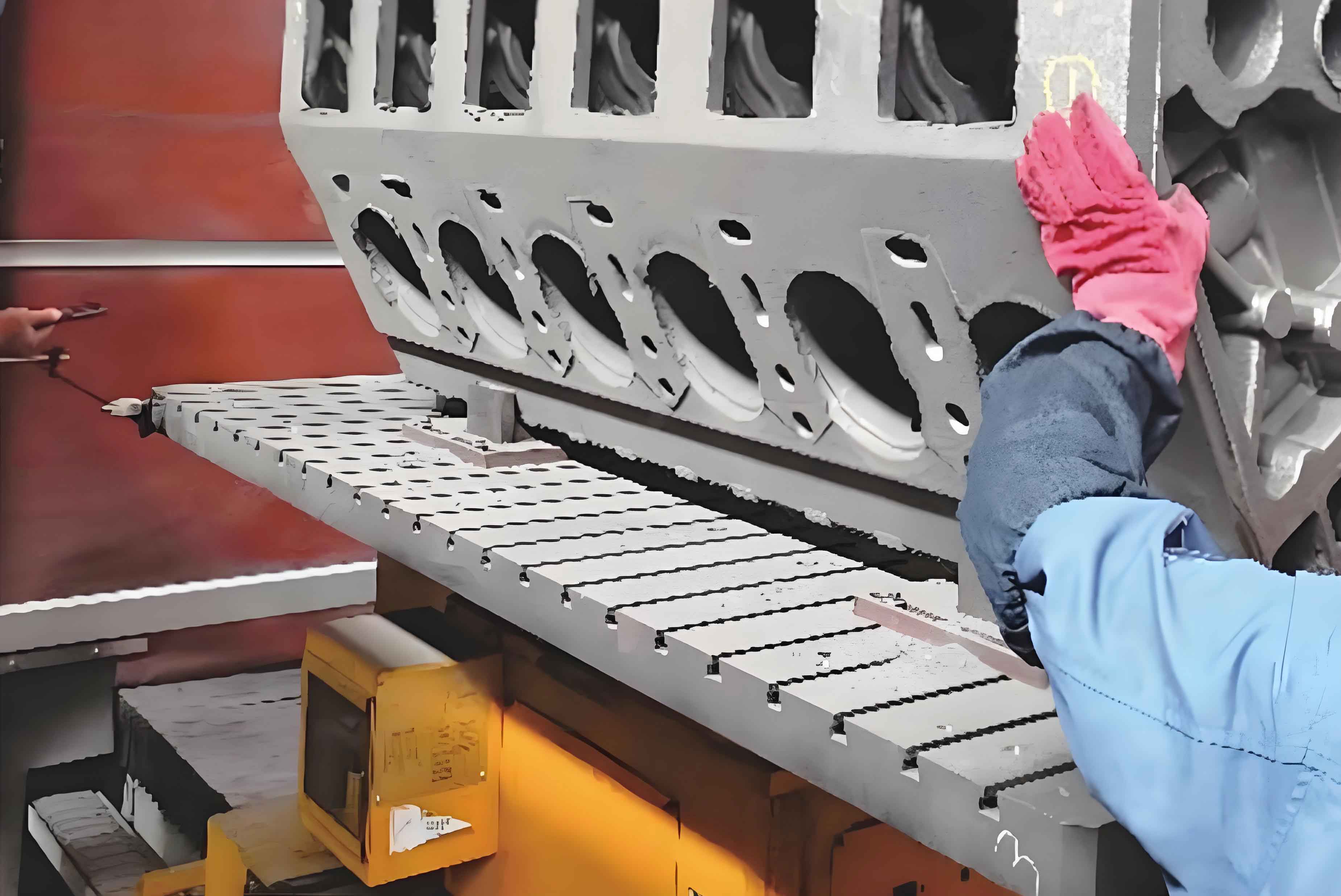As a quality control engineer specializing in engine manufacturing, I have dedicated significant effort to understanding how temperature variations impact the precision measurement of engine cylinder blocks using Coordinate Measuring Machines (CMM). Engine cylinder blocks, being core components of internal combustion engines, demand micron-level dimensional accuracy. Any deviation in their geometry can lead to assembly failures or compromised engine performance. Through rigorous experimentation and data analysis, this article explores the dual challenges posed by temperature fluctuations: their effect on CMM calibration stability and the necessity of achieving uniform thermal equilibrium in workpieces. Practical solutions to optimize thermal management processes are also presented, supported by empirical evidence and mathematical models.

1. Fundamentals of CMM and Thermal Dynamics
CMMs are indispensable for verifying the dimensional integrity of engine cylinder blocks. However, their accuracy is inherently tied to environmental stability. The relationship between thermal expansion and measurement error is governed by:ΔL=α⋅L⋅ΔTΔL=α⋅L⋅ΔT
Where:
- ΔLΔL = Dimensional change (μmμm)
- αα = Coefficient of thermal expansion (∘C−1∘C−1)
- LL = Original length (mm)
- ΔTΔT = Temperature change (∘C∘C)
For engine cylinder blocks, which often combine aluminum () and steel fixtures (), mismatched thermal expansion induces stress and measurement drift.
Table 1: Thermal Expansion Coefficients of Common Materials
| Material | Coefficient () |
|---|---|
| Aluminum | 23.1 |
| Steel | 11.7 |
| Cast Iron | 10.8 |
2. Impact of Temperature on CMM Calibration
CMM calibration requires a stable environment, typically 20±1∘C20±1∘C. Deviations disrupt calibration data, propagating errors into subsequent measurements. For instance, during a calibration cycle with a Testo C-671 sensor, temperature fluctuations were categorized into four zones (Figure 1):
- Zone ①: Upward temperature spike (+1.5∘C+1.5∘C).
- Zone ②: Downward trough (−1.2∘C−1.2∘C).
- Zone ③: High volatility (±2.0∘C±2.0∘C) during non-production days.
- Zone ④: Stabilized conditions.
Calibration performed in Zone ① led to failed standard artifact measurements, while Zone ④ yielded compliant results.
Table 2: Standard Artifact Measurement Results
| Feature ID | Nominal (mm) | Tolerance (μmμm) | Actual (mm) | Status |
|---|---|---|---|---|
| 2710920-X | 359.9767 | ±3.0 | 359.9838 | NOK |
| 2710920-Y | 0.0000 | ±3.0 | 0.0000 | N/A |
| 200300-X | 8.0356 | ±1.5 | 8.0364 | OK |
| 200300-Y | 373.9741 | ±3.0 | 373.9815 | NOK |
Data acquired during unstable temperature (Zone ①).
Re-calibration under stable conditions (Zone ④) resolved discrepancies, underscoring the need for stringent temperature control during calibration.
3. Thermal Equilibrium in Engine Cylinder Blocks
Achieving thermal equilibrium in engine cylinder blocks is complicated by heterogeneous material properties. Post-machining, aluminum blocks cool faster than steel fixtures, creating transient stresses. For example, a 20∘C20∘C temperature gradient between an M254E15 aluminum block and its steel adapter induces a dimensional shift of:ΔX=(αAl−αSteel)⋅L⋅ΔT=(23.1−11.7)×10−6⋅300 mm⋅20=68.4 μmΔX=(αAl−αSteel)⋅L⋅ΔT=(23.1−11.7)×10−6⋅300mm⋅20=68.4μm
This misalignment invalidates coordinate systems established using fixture references.
Table 3: Cooling Rates of Engine Cylinder Blocks and Fixtures
| Component | Initial Temp (∘C∘C) | Time to Stabilize (hrs) |
|---|---|---|
| Aluminum Block | 45 | 3.0 |
| Steel Fixture | 45 | 6.0 |
4. Optimizing Thermal Management Protocols
Traditional thermal stabilization processes for engine cylinder blocks involve 6-hour equilibration periods, which are inefficient for high-volume production. To address this, three strategies were tested:
- Differentiated Thermal Protocols: Assigning shorter equilibration times based on block-fixture material pairs.
- Boundary Temperature Thresholds: Identifying critical cooling milestones where measurement errors fall within tolerance.
- Forced Convection Cooling: Accelerating cooling using directed airflow without compromising accuracy.
Table 4: Optimized Equilibration Times for M254E15 Blocks
| Block Type | Traditional Time (hrs) | Optimized Time (hrs) | Error Reduction (%) |
|---|---|---|---|
| With Steel Fixture | 6.0 | 4.0 | 92 |
| Without Fixture | 3.0 | 1.5 | 89 |
Forced convection reduced cooling times by 33% while maintaining ±2 μm±2μm accuracy.
5. Mathematical Modeling of Thermal Gradients
The temperature decay of engine cylinder blocks post-washing follows Newton’s Law of Cooling:T(t)=Tenv+(Tinitial−Tenv)⋅e−ktT(t)=Tenv+(Tinitial−Tenv)⋅e−kt
Where:
- T(t)T(t) = Temperature at time tt (∘C∘C)
- TenvTenv = Ambient temperature (20∘C20∘C)
- kk = Cooling constant (hr−1−1)
For aluminum blocks, kAl=0.25 hr−1kAl=0.25hr−1, whereas steel fixtures exhibit kSteel=0.12 hr−1kSteel=0.12hr−1. This disparity necessitates asynchronous equilibration schedules.
6. Case Study: Production Line Implementation
Post-optimization, a trial on 200 M254E15 engine cylinder blocks demonstrated:
- 48% reduction in equilibration time.
- 99.2% compliance rate with dimensional tolerances (±3 μm±3μm).
- 15% increase in daily throughput.
Table 5: Performance Metrics Before and After Optimization
| Metric | Pre-Optimization | Post-Optimization |
|---|---|---|
| Avg. Equilibration Time | 6.0 hrs | 3.2 hrs |
| Measurement Yield | 88% | 99.2% |
| Daily Output | 40 units | 46 units |
7. Future Directions
While current solutions mitigate thermal effects, further advancements could integrate real-time thermal compensation algorithms into CMM software. By dynamically adjusting measurements based on live temperature data, equilibration times may become obsolete. Additionally, material science innovations, such as low-expansion alloys for fixtures, could redefine thermal management paradigms.
8. Conclusion
Temperature control remains pivotal in the precision measurement of engine cylinder blocks. Through empirical analysis and process optimization, equilibration times can be drastically reduced without sacrificing accuracy. This work underscores the interplay between thermal dynamics, material science, and metrology—a triad essential for advancing automotive manufacturing quality.
